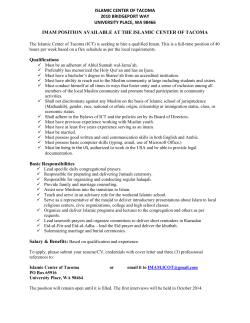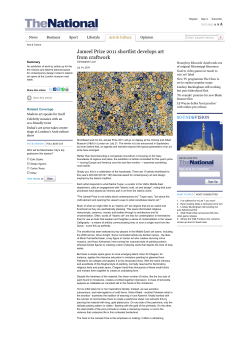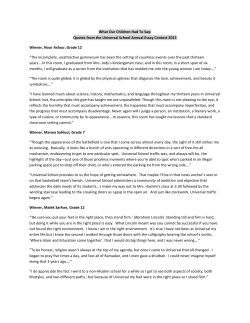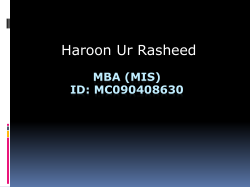
Convivencia
La Convivencia La Convivencia (literally “the Coexistence”) is a period of time in Spanish history, lasting almost 800 years, dating from 711 C.E. (the Umayyad conquest of Spain) To 1492 C.E. Islamic expansion 622 C.E. - 750 C.E. Al-Andalus ( ) األندلس Al-Andalus refers to the parts of the Iberian peninsula occupied by Muslims between 711 C.E. And 1492 C.E. Courtyard and fountain of the Alhambra, Granada, Spain Islamic Architecture The Cathedral of Cordoba,formerly the Great Mosque of Cordoba, built in 742 C.E. It is the center of the largest urban site declared a “World Heritage Site” by UNESCO. Islamic Architecture A portico in The Alhambra, Granada, Spain. Islamic Architecture Ornamental relief, The Alhambra, Granada Spain. Jewish Architecture West wall of the Synagogue of Cordoba, built in 1315 C.E. Jewish Architecture Interior of Santa Maria la Blanca, originally The Congregational Synagogue of Toledo, Spain. Built in 1180, it is the oldest synagogue in Europe still standing. Jewish Architecture Interior Dome of the Toledo Synagogue Golden Age of Jewish Culture in Spain, 700 C.E. - 1100 C.E. Manuscript page, by Maimonides. Arabic language using Hebrew letters. Golden Age of Jewish Culture in Spain, Maimonides Maimonides, whose name in Hebrew is ( רבי משה בן מימוןRabbi Moshe ben Maimon, or “Rambam”) and whose full name in Arabic is ابو عمران موسى بن ميمون بن عبد هللا القرطبي was born in Cordoba, Spain on Passover Eve 1135 C.E. He was one of the greatest Torah scholars, philosophers and physicians of the Middle Ages. He is the author of a 14 volume work (Mishneh Torah) and the Guide to the Perplexed. He read the ancient Greek philosophers in Arabic translation, and was immersed in Islamic science and culture. After Cordoba was conquered in 1148 he and his family chose exile in Morroco, then Egypt. Golden Age of Jewish Culture in Spain, Maimonides (cont'd) Maimonides strove to reconcile Aristotelian philosophy and science with the teachings of the Torah. His most famous non-theological work is the “Guide to the Perplexed” Book 1: Critique against the “anthropomorphism of God”. Development of “negative theology” - God can only be described in terms of negatives, eg God is not bound by time God is not subject to change Book 2: Exposition on the physical structure of the universe (from an Aristotelian viewpoint). Book 3: Analysis of the moral aspects of the universe The problem of existence of evil Free Will, Providence, Omniscience First page of 1553 edition, in Hebrew Christian Architecture Cathedral of Granada, built on the site of the Great Mosque of Granada (early 16th century). Blended Architecture The Gothic-Mudejar Cathedral of La Seo in Zaragoza This shows a unique blending of Islamic and Christian architectural forms. Blended Architecture The dome of the Cathedral of Teruel. This is an example of the Mudejar architecture of Aragon, Spain. This region has been denoted a World Heritage Site by UNESCO. Blended Architecture Tower of the church of Our Lady of the Assumption, in Utebo (which is in Zaragoza, Spain) Blended Architecture The Mudejar style, a symbiosis of techniques and ways of understanding architecture resulting from Muslim, Christian and Jewish cultures living side by side. Islamic Mathematics The Byzantine Empire (Eastern Roman Empire) provided the medieval Islamic world with ancient Greek texts in science and mathematics, medicine and philosophy. These were then translated into Arabic. A westerner and an Arab learning geometry (circa 15th century). Islamic Mathematics The most important contribution of Islamic Mathematics was the development of Algebra. Algebra comes from the phrase hisab al-jabr w'almuqabala which means “calculus of resolution and juxtaposition” Al-jabr became “algebra” Cubic Equations and the Intersection of Conic Sections, from the works of Omar Khayam Medieval Jewish Medicine Isaac Israeli ben Solomon, born in Cairo Egypt, lived from approximately 850 CE – 940 CE. He was court physician to Prince Ziyadat Allah III. His medical works were written in Arabic, then translated into Latin, and were textbooks in Scuola Medica Salernitana (Salerno was the first University in Western Europe). Islamic Medicine “The Eye,” by Hunain ibn Ishaq, from a manuscript circa 1200 C.E. Hunain ibn Ishaq was an Assyrian Christian, and lived from 809-873 C.E. He was the chief translator of Greek texts into Syrian and Arabic, including the complete works of Galen – the most accomplished medical researcher of antiquity. Islamic Medicine Skeletal System Muscular System Vascular System Copies of early Arab anatomical charts, made in India around 950 C.E. The organs Islamic Science Prominent areas of study include: – – – – – – – – Mathematics (Al-Khwarizmi) Astronomy (Abd al-Rahman al-Sufi) Medicine (Al Zahrawi) Physics (Alhazen) Alchemy/Chemistry (Jabir ibn Hayyan) Cosmology (al-Farghani) Opthamology (Hunain ibn Ishaq) Geography/Cartography (Muhammed al-Idrisi)
© Copyright 2025



















